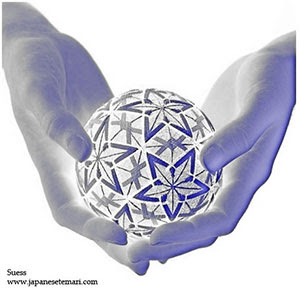 |
A temari stitched with interlocking
pentagons and hexagons |
Update Wednesday morning: when this stitch along is over, I will offer to send you a pdf of the directions that you can save on your computer or print. Will trade for a photo of your marked ball to publish on my blog. So keep busy!
Last weekend, I marked a ball with 42 centers and finally took the time to figure out my favorite way. Like most things in the craft of temari, there are several ways to get to the same end point. When I teach classes, I like to point out my favorite way of making temari and also give alternatives. For instance, when wrapping the ball with thread, do you wrap over the top and away from your body or up from the bottom and towards yourself? Either way works!
This method of marking 42 centers requires no measuring. That's right! You'll use your eye, not your tape measure. 42 centers is the first of the multis that is based on the C10 diamond. When all is done, you will have added more guidelines that cut through the sides of the diamonds at their halfway points. Over the next week, I'll be posting the steps for my favorite method. Today is the prep so get ready!
Gather your supplies:
30 - 35cm circumference ball wrapped in a color of your choice. Make the final layer of thread wrap fairly thick and randomly wrapped. You'll be making a lot of stitches and placing a lot of pins into the ball and you want them to stay in place.
Mark a combination 10 division. Do your best! Measure everything to make sure. I like to measure the long lines of each C10 triangle, one triangle at a time. I place a pin in the center of the triangle and measure the long lines that go out to the corners. I often have to adjust the placement of the pin just a bit to center it. When I know I'm going to continue adding support lines, I do not tack at the triangle center right away. I'll leave the pin in place and tack when I've changed that 6-way intersection into a 12-way intersection with the support lines. Go ahead and tack the 10-way intersections at the centers of the pentagons.
Guideline thread - your favorite thread in a color of your choice. For multicenters markings, I prefer a thinner metallic like Treasure Braid Petite by Rainbow Gallery. #12 pearl cotton is also good if you prefer cotton. If this is your first attempt at marking 42 centers, use one color for the C10 marking and another color for the support lines you'll add. BTW, "support lines" are any lines you add after the original basic marking like the C10.
Pins. In Step 3, you’ll place pins by eye to keep the threads from rolling off the ball. For this task, I recommend using
pins with small tops (size 17 Dritz). You can buy them in boxes of 100 or 200 pins. This size is my go-to pin for more advanced designs when I've got a lot of marking to do. You can push them down to the surface of the ball and there is less chance of your thread catching on them.
Step 1 - coming in a few days. See you then!
If you have any questions, please join the conversation on TemariChallenge Yahoo group.
References:
Shapes on a C10 division
Multicenters markings
Schedule of posts for this stitch along:
Step 1 on December 11 - first wraps
Step 2 on December 14 - pin placement
Step 3 on December 16 - last set of wraps
Step 4 on December 18 - adjust and tack. Suggestions for designs.


















































